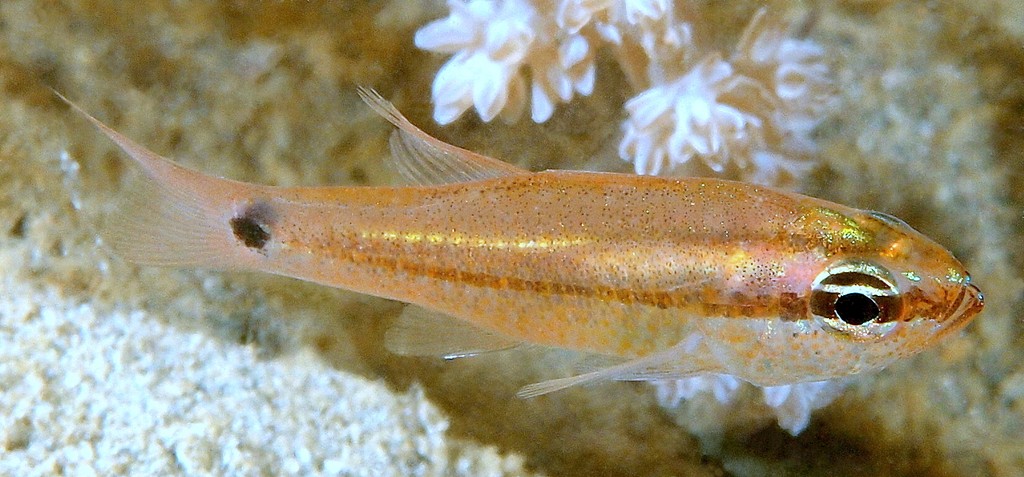OSTORHINCHUS CLADOPHILOS - (ALLEN & RANDALL, 2002)
Actinopterygii (Gigaclass) > Actinopteri (Class) > Teleostei (Subclass) > Gobiiformes (Order) > Apogonoidei (Suborder) > Apogonidae (Family) > Apogoninae (Subfamily) > Ostorhinchus (Genus)
Shelter cardinalfish, Mosaic-line cardinalfish,
Shelter cardinalfish, Mosaic-line cardinalfish,
Synonyme
Apogon cladophilos (Allen & Randall, 2002)
Apogon cladophilos (Allen & Randall, 2002)
---------------------------
Description
Dorsal spines (total): 8; Dorsal soft rays (total): 9; Anal spines: 2; Anal soft rays: 9; All dorsal and anal soft rays branched, the last to base; Pectoral rays: 14, the lowest and uppermost pair unbranched; Pelvic rays: I,5, all rays branched; Principal caudal rays: 17, the upper and lower rays unbranched; upper and lower procurrent caudal rays: 8-10, the most posterior (and occasionally the one preceding it) segmented; Lateral line scales: 24, plus 3 pored scales posterior to hypural plate; Scales above lateral line to origin of dorsal fin: 2; Scales below lateral line to origin of anal fin: 5-6; Median predorsal scales: 4; Circumpeduncular scales: 12; Developed gill rakers: 4 + 16 (4-5 + 16-17), usually: 1-2 tiny rudiments at beginning of upper limb; Branchiostegal rays: 7; Supraneural (predorsal) bones: 3; Vertebrae: 10 + 14. Max. length: 6.0 cm TL. Depth range: 2 - 35 m.
Color
Overall translucent to whitish with silvery reflections on head and belly; A diffuse to distinct brown stripe extending from snout tip through eye to middle of base of caudal fin, tapering posteriorly and ending in prominent black spot (about pupil size or slightly larger); A pair of silvery stripes on snout passing through eye at level of upper and lower margin of pupil; Fins translucent whitish.
Etymology
Ostorhinchus: from Greek, osteon = bone + from Greek, rhynchos = beak. In reference to the bony jaws, very much advanced and jagged, which take the place of the teeth.
cladophilos: from the Greek, klados = a branch + from Greek, philo = loving. Name given in reference to its habit of sheltering among branches of antipatharian and alcyonarian corals as well as sea urchins.
Original description: Apogon cladophilos Allen & Randall, 2002 - Type locality: Lizard Island, (approximately 14°40’S, 145°28’E), Great Barrier Reef, Australia: off Granite Bluff, in 20 m, rotenone, J. E. Randall and H.W. Kendall, 10 December 1982.
Distribution
Western Pacific: Indonesia, Great Barrier Reef (Australia) and New Caledonia.
Dorsal spines (total): 8; Dorsal soft rays (total): 9; Anal spines: 2; Anal soft rays: 9; All dorsal and anal soft rays branched, the last to base; Pectoral rays: 14, the lowest and uppermost pair unbranched; Pelvic rays: I,5, all rays branched; Principal caudal rays: 17, the upper and lower rays unbranched; upper and lower procurrent caudal rays: 8-10, the most posterior (and occasionally the one preceding it) segmented; Lateral line scales: 24, plus 3 pored scales posterior to hypural plate; Scales above lateral line to origin of dorsal fin: 2; Scales below lateral line to origin of anal fin: 5-6; Median predorsal scales: 4; Circumpeduncular scales: 12; Developed gill rakers: 4 + 16 (4-5 + 16-17), usually: 1-2 tiny rudiments at beginning of upper limb; Branchiostegal rays: 7; Supraneural (predorsal) bones: 3; Vertebrae: 10 + 14. Max. length: 6.0 cm TL. Depth range: 2 - 35 m.
Color
Overall translucent to whitish with silvery reflections on head and belly; A diffuse to distinct brown stripe extending from snout tip through eye to middle of base of caudal fin, tapering posteriorly and ending in prominent black spot (about pupil size or slightly larger); A pair of silvery stripes on snout passing through eye at level of upper and lower margin of pupil; Fins translucent whitish.
Etymology
Ostorhinchus: from Greek, osteon = bone + from Greek, rhynchos = beak. In reference to the bony jaws, very much advanced and jagged, which take the place of the teeth.
cladophilos: from the Greek, klados = a branch + from Greek, philo = loving. Name given in reference to its habit of sheltering among branches of antipatharian and alcyonarian corals as well as sea urchins.
Original description: Apogon cladophilos Allen & Randall, 2002 - Type locality: Lizard Island, (approximately 14°40’S, 145°28’E), Great Barrier Reef, Australia: off Granite Bluff, in 20 m, rotenone, J. E. Randall and H.W. Kendall, 10 December 1982.
Distribution
Western Pacific: Indonesia, Great Barrier Reef (Australia) and New Caledonia.
Biology
Benthic species which inhabits coral reef. Forms groups that shelter among urchins, black corals and gorgonians.
Similar species
Ostorhinchus capricornis (Allen & Randall, 1993) - Reported from New Caledonia - Link to the species (here).
Benthic species which inhabits coral reef. Forms groups that shelter among urchins, black corals and gorgonians.
Similar species
Ostorhinchus capricornis (Allen & Randall, 1993) - Reported from New Caledonia - Link to the species (here).
Ostorhinchus diversus (Smith & Radcliffe, 1912) - Reported from Western Pacific.
Ostorhinchus flavus (Allen & Randall, 1993) - Reported from New Caledonia - Link to the species (here).
Last update: 20, September 2022
